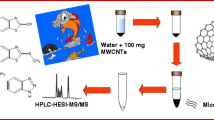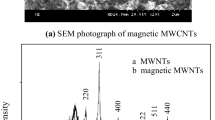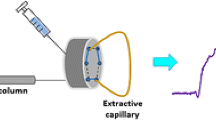Abstract
Metformin is the largest drug produced globally in metric tons. It has been reported in many water treatment plants and water resources. The analysis of metformin at trace level is important before supplying water to the communities. The present article describes solid-phase micromembrane tip extraction and capillary electrophoretic methods for the analysis of metformin in water using multi-walled carbon nanotubes as a sorbent in the sample preparation method. The maximum extraction of metformin was achieved at 10.0 mg/L metformin, 25 shaking time, 0.5 g/L CNTs dose, 7.0 sorption pH, 30-min desorption time and 12 desorption pH. The migration time of metformin was 8.4 min with 2.0 × 10–4, 1.35 × 10–4 and 15,600 as electrophoretic mobility (cm2V−1 s−1), electroosmotic mobility (cm2V−1 s−1) and the number of theoretical plates. These solid-phase micromembrane tip extraction and capillary electrophoretic methods were highly applicable to monitor metformin in the wastewater. The reported methods are efficient, reproducible and useful for the estimation of metformin in water and may be exploited for the analysis of the metformin water resource.





Similar content being viewed by others
References
Alajmi MF, Hussain A, Taqui SN, Ali I (2017) Solid-phase micro membrane tip extraction and capillary electrophoresis of metformin in urine samples. Curr Pharm Anal 13:403–409
Ali I, Gupta VK, Aboul-Enin HY (2003) Chirality: a challenge for the environmental scientists. Cirr Sci 84:152–156
Ali I, Gupta VK, Aboul-Enein HY, Hussain A (2008) Hyphenation in sample preparation: advancement from micro to nanoworld. J Sep Sci 31:2040–2053
Ali I (2011) Nano anti-cancer drugs: pros and cons and future perspectives. Curr Can Drug Targets 11:131–134
Ali I, Rani D, AL-Othman ZA (2016) Analysis of ibuprofen, pantoprazole and itopride combination therapeutic drugs in human plasma by solid-phase membrane micro tip extraction (SPMMTE) and high-performance liquid chromatography (HPLC) methods using new generation Core-Shell C18 column. J Liq Chromatogr Rel Technol 39:339–345
Ali I, Alothman ZA, Alwarthan A (2017) Supramolecular mechanism of the removal of 17-β-estradiol endocrine disturbing pollutants from the water on functionalized iron nanoparticles. J Mol Liq 441:123–129
Blair BD, Crago JP, Hedman CJ, Klaper RD (2013a) Pharmaceuticals and personal care products found in the Great Lakes above concentrations of environmental concern. Chemosphere 93:2116–2123
Blair BD, Crago JP, Hedman CJ, Treguer RJF, Magruder C, Royer LS, Klaper RD (2013b) Evaluation of a model for the removal of pharmaceuticals, personal care products, and hormones from water. Sci Total Environ 444:515–521
Burakova E, Dyachkova TP, Rukhov AV, Tugolukov EN, Galunin EV, Tkachev AG, Basheer AA, Ali I (2018) Novel and economic method of carbon nanotubes synthesis on a nickel magnesium oxide catalyst using microwave radiation. J Mol Liq 253:340–346
Chhetri HP, Thapa P, Schepdael AV (2014) Simple HPLC-UV method for the quantification of metformin in human plasma with one step protein precipitation. Saudi Pharmaceut J 22:483–487
Elo B, Villano CM, Govorko D, White LA (2007) Larval zebrafish as a model for glucose metabolism: expression of phosphoenolpyruvatecarboxykinase as a marker for exposure to anti-diabetic compounds. J Mol Endocrinol 38:433–440
Elovich SY, Zhabrova GM (1939) Mechanism of the catalytic hydrogenation of ethylene on nickel. Kinetics of the process. J Phys Chem 13:1761
Fatta-Kassinos D, Meric S, Nikolaou A (2011) Pharmaceutical residues in environmental waters and water: current state of knowledge and future research. Anal Bioanal Chem 399:251–275
Ghoshdastidar AJ, Fox S, Tong AZ (2014) The presence of the top prescribed pharmaceuticals in treated sewage effluents and receiving waters in Southwest Nova Scotia. Canada Environ Sci Pollut Res Int 22:1–12
Gu W (2016) Metformin: methods of analysis and its role in lowering the risk of cancer. J Bioequival Bioavailabil 8:254–259
Heberer T (2002) Occurrence, fate, and removal of pharmaceutical residues in the aquatic environment: a review of recent research data. Toxicol Lett 131:5–17
Ho YS, McKay G (1999) Pseudo-second order model for sorption processes. Process Biochem 34:451–465
Hussain I, Ali I, Rahman H, Ghani SS (2017) Novel contribution of chromatography in the development and analyses of metformin hydrochloride in biological and environmental samples. J Liq Chromatogr Relat Technol 40:599–615
Lagergren S (1898) Zur Theorie der Sogenannten Adsorption Gelöster Stoffe. Kungliga Svenska Vetenskapsakademiens Handlingar 24:1–39
Markiewicz M, Jungnickel C, Stolte S, Białk-Bielinska A, Kumirska J, Mrozik W (2017) Primary degradation of antidiabetic drugs. J Hazard Mater 324:428–435
Maruthur NM, Tseng E, Hutfless S, Wilson LM, Suarez-Cuervo C, Berger Z, Chu Y, Iyoha E, Segal JB, Bolen S (2016) Diabetes medications as monotherapy or metformin-based combination therapy for type 2 diabetes: a systematic review and meta-analysis. Ann Intern Med 164:740–751
Maulidiani M, Abas F, Rudiyanto R, Kadir NHA, Zolkeflee NKZ, Lajis NH (2020) Analysis of urinary metabolic alteration in type 2 diabetic rats treated with metformin using the metabolomics of quantitative spectral deconvolution 1H NMR spectroscopy. Microchem J 153:104513
Niemuth NJ, Jordan R, Crago J, Blanksma C, Johnson R, Klaper RD (2015) Metformin exposure at environmentally relevant concentrations causes potential endocrine disruption in adult male fish. Environ Toxicol Chem 34:291–296
Nodeh HR, Ibrahim WAW, Ali I, Sanagi MM (2016) Development of magnetic graphene oxide adsorbent for the removal and pre-concentration of As(III) and As(V) species from environmental water samples. Environ Sci Pollut Res 23:9759–9773
Oertel R, Baldauf J, Rossmann J (2018) Development and validation of a hydrophilic interaction liquid chromatography-tandem mass spectrometry method for the quantification of the antidiabetic drug metformin and six others pharmaceuticals in water. J Chromatogr A 1556:73–80
Panserat S, Skiba-Cassy S, Seiliez I, Lansard M, Plagnes-Juan E, Vachot C, Aguirre P, Larroquet L, Chavernac G, Medale F, Corraze G, Kaushik S, Moon TW (2009) Metformin improves postprandial glucose homeostasis in rainbow trout fed dietary carbohydrates: a link with the induction of hepatic lipogenic capacities? Am J Physiol Regu Integr Comp Physiol 297:R707–R715
Polakof S, Skiba-Cassy S, Panserat S (2009) Glucose homeostasis is impaired by a paradoxical interaction between metformin and insulin in carnivorous rainbow trout. Am J Physiol Regul Integr Comp Physiol 297:R1769–R1776
Polakof S, Moon TW, Aguirre P, Skiba-Cassy S, Panserat S (2011) Glucose homeostasis in rainbow trout fed a high-carbohydrate diet: metformin and insulin interact in a tissue-dependent manner. Am J Physiol Regul Integr Comp Physiol 300:R166–R174
Sahra B, Le Marchand-Brustel Y, Tanti J-F, Bost F (2010) Metformin in cancer therapy: a new perspective for an old antidiabetic drug? Mol Can Ther 9:1092–1099
Yan JH, Xiao Y, Tan DQ, Shao XT, Wang Z, Wang DG (2019) Wastewater analysis reveals spatial pattern in consumption of anti-diabetes drug metformin in China. Chemosphere 222:688–695
Acknowledgements
The authors are grateful to the Deanship of Scientific Research, King Saud University, for funding through Vice Deanship of Scientific Research Chairs and thankful to the financial support funded by the Deanship of Scientific Research at Princess Nourah bint Abdulrahman University through the Fast-track Research Funding Program.
Author information
Authors and Affiliations
Corresponding author
Ethics declarations
Conflict of interest
The authors declare that they have no conflict of interest.
Additional information
Editorial responsibility: Samareh Mirkia.
Rights and permissions
About this article
Cite this article
ALOthman, Z.A., Alsheetan, K.M., AL-Anazy, M.M. et al. Metformin residue analysis in water by MWCNTs-based solid-phase micromembrane tip extraction and capillary electrophoresis methods. Int. J. Environ. Sci. Technol. 18, 3419–3426 (2021). https://doi.org/10.1007/s13762-021-03218-0
Received:
Revised:
Accepted:
Published:
Issue Date:
DOI: https://doi.org/10.1007/s13762-021-03218-0




